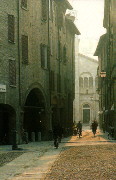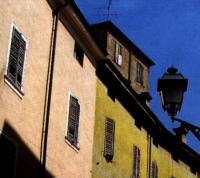|
|
The beds of the Secchia and Panaro rivers pave the city's streets |
|
|
|
|
City of two rivers The pragmatism of the '50s covered all Modena's cobbled streets with asphalt, pleasing cyclists and saving ladies' high heels, but destroying some of the unique character of this city of two rivers. Cobbles restored A series of restoration campaigns have set out to return the city centre streets to something like their original appearance. Walking around the various parts of the city, one will notice that the restorers' taste has varied occasionally, but in all cases the main ingredients are riverbed cobble-stones, combined in many different ways with the grey of slabs of gneiss. North of the Via Emilia The restoration work has focused on two streets which meet in a T-junction, via Cesare Battisti and via Taglio; in the former, the entire road-bed between the pavements is in river cobbles, while the second, paved completely with gneiss flags, looks like a vast open-air drawing-room (lined with attractive shops and open to pedestrians only) which finishes at the apse of the church of San Giorgio, in a quiet corner of piazzetta Molinari with a fountain. South of the Via Emilia More work has been done in this area, although it has taken place in patches and various methods have been used. In the southernmost part of the city, around the main streets of corso Canal Chiaro and via Francesco Selmi, via San Geminiano, via Grasolfi, rua Dei Frati Minori, via San Paolo and via Tre Re are all cobbled, while via San Salvatore, via Cervetta, via Trivellari and via Francesco Selmi feature a central strip of gneiss. To the east, there are interesting variations on the theme of the "trottatoi", strips of flat stone laid in the past to provide a smooth passage for carriage wheels, which are both attractive and functional today. In corso Adriano there is just a single band of gneiss in the midst of the cobbles, while in via Gallucci and via Scarpa (on opposite sides of corso Canal Grande) there are only three strips of cobbles between the gneiss "trottatoi" and pavements. Via Tintori, which runs parallel to via Scarpa but was restored at a later date, uses the same materials in a different way, with one central line of gneiss and two wide cobbled "trottatoi". 
The rebirth of via Carteria and via S. Eufemia
Via Carteria, in an attractive but run-down
part of the city now undergoing restoration after the closure
of the S. Eufemia prison, has been re-paved in exactly the same
way as via del Tintori. The street, one of the longest running
North-South, links via Emilia Ovest with piazzale San Francesco,
offering pedestrians a new route as an alternative to Canal Chiaro.
The street twists and turns, very narrow in some points where
there are arcades on both sides and opening out at the junctions
with small side-streets. There are two small squares along the
way, one behind the apse of the deconsecrated church of S. Giacomo
(where a statue by Graziosi adorns a little fountain) and the
other in front of the XVIII Century facade of the church of San
Barnaba, with its sculpture and bright yellow ochre and red painted
plaster. Although dulled by time, the interior shows signs of
XVIII Century splendour in the frescoed ceiling with perspective
illusions and the rich side chapels with inlaid marble altars.
Dating from the same period, the four walnut confessionals, with
their attractive carved volutes and foliage, are also in Baroque
style.
The latest restoration work in Modena has involved via S. Eufemia. Beginning opposite the cathedral, this street opens out to form a small square in front of the church of the same name, before crossing via Carteria. The uniform gneiss paving, alternating with cobbles only in the square, has provided a real face-lift for this street, which offers an attractive view of the facade of the cathedral with the Ghirlandini and Palazzo Comunale towers behind it. Immediately to the west of via Carteria stands the former Santa Chiara barracks, cleverly restored to combine reminders of the devastating effect of the war (the remaining fragments of wall have not been rebuilt) with an excellent example of re-adaptation to the needs of daily life and culture (it houses residential apartments and the Circolo Cinematografico Truffaut). The adjoining streets, via Malatesta, via dell'Alloro, via Santa Chiara and via delle Rose have also been restored, with large-scale use of cobbles. Piazzetta S. Francesco, at the southern tip of the old city Cobbles have also been used in Piazzetta S. Francesco, around the fountain by Graziosi which shows the Saint preaching to the birds. This is the end of Corso Canalchiaro, which has the twist and turns, and thus ever-changing views, typical of streets built along the routes of old canals. This is certainly one of Modena's most attractive streets, thanks to the large amount of restoration work done, the arcades of constantly changing height and width, the use of decorative brickwork around doors and windows, and an aristocratic XV Century house in unplastered brick. |
|
© 1997 - Provincia di Modena - Made by
|
|
